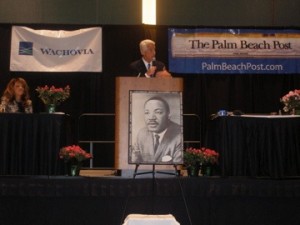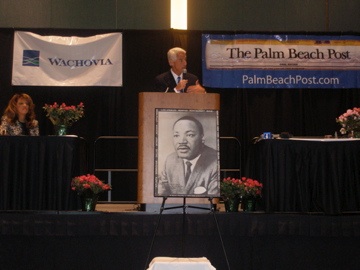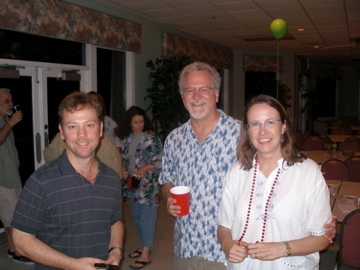ìI hardly have time to go to the bathroom,î said then-Washington Post ombudsman Deborah Howell. ìStart a blog?î
Before we survey the recent Washington, D.C. meeting of the world’s news ombudsmen, indulge me a look back at our meetings last year in Stockholm and two years ago at Harvard.
Amid all the breaking changes at my former newspaper, I missed ONO’s 2008 Stockholm sessions.
That was regrettable. Not only because I had told my Swedish counterpart, Lilian Ohrstrom, that I really hoped to be present. And because it would have been great to check out her city where colleagues reported the sun didn’t set until around midnight, and rose again around 4 a.m.
What I also missed was sharing in the continuum of my colleagues’ thinking regarding what Buzzmachine.com blogger Jeff Jarvis succinctly had summarized during the previous year’s meeting: ìThe architecture of news is changing, because it can.î
Fortunately, our website carried ìReports from the 2008 ONO Conference.î They’re still available. Including the welcome from Par-Arne Jigenius, former Swedish national press ombudsman, ìto the native country of the ombudsman institutionî (not to mention the gender-neutral Swedish word).
I also liked what I heard in then-ONO President Pam Platt’s weblog reports. Such as:
ìThe international nature of the Organization of News Ombudsmen is one of its greatest assets. It is inspiring to meet and talk with people from around the world who are committed to a free and fair press and who advocate for the reader, viewer, user or consumer. We come from different places but there are great common denominators to what we do, and what we encounter on the job.î
There’s plenty more at our website from ONO’s 2008 Stockholm meeting for media watchers who may have missed it. For example, our current president, Stephen Pritchard of the London Observer, noted web developer Joakim Jardenberg’s suggestion that, given the sniping between mainstream media and bloggers, we should ìstop calling ourselves ombudsmen and look upon ourselves as nurturers of an online community.î
But looking back yet another year: Unlike at the earlier Istanbul, St. Petersburg FL, London and Sao Paulo meetings of our increasingly international group, I thought our digital focus really crystallized in 2007 in Cambridge, MA.
ìOmbudsmen in a Time of Transitionî was an appropriate theme.
The sessions at the Nieman Foundation’s Walter Lippmann House headquarters came against the emerging background for newspapers and news ombudsmen of a firmly entrenched phenomenon of blogs.
In addition the Harvard meeting was our first that I had attended in more than 20 years from which we blogged reports to our website — itself another tool ONO did not have two decades ago.
As my colleague Ms. Howell’s comment above also suggests, blogging news ombudsmen still were the exception. In contrast was ONO member Jose Carlos Abrantes of the 140-year-old Povedor dos Leitores, Diario de Noticia of Lisbon, Portugal: ìI am a blogger since 2002 — five years,î he said. ìAnd I have five blogs.î
Most memorable for me were self-described ìBlogger Guyî Jarvis’ thought-provoking suggestions — which I blogged from the meeting for our website — from the session, ìIs There a Shared Watchdog Role for the Public, the Blogs & Ombudsmen?î
ìWe’re better off if we start to see stories as a process rather than a product,î he said. Sometimes, ìYou put up what you know and say this is what we don’t know, what do you know?î
He also said the best thing a newspaper can contribute to the conversation with its community is facts; so why not solicit some from, for example, the countless people who can tell how well computers are being used in a community’s elementary schools.
I still regularly check Jarvis’s thoughts regarding the possibilities for newspapers (he’s not optimistic), and for other kinds of media. Anyone who really cares about all this should check out his July 4 post on ìJournalistic narcissism.î Talk about ìindependence.î
Along with my own report to Palm Beach Post readers, there’s more leisure reading online from that meeting. For example the thoughts of Alan Rusbridger, editor of the consistently groundbreaking British newspaper The Guardian, which hosted our London meeting. (That’s some of us above in the center header photo at The Guardian’s visitor center, The Newsroom.)
Ms. Platt aptly summarized the editor’s comments on ìOmbudsmen in the digital futureî:
ìThe new model of journalism is more fluid, and demands more transparency. Trust, he said, is the only thing in the end that we have going for us, and that calls for ‘a searching examination of what we mean by journalism.’ î
Although spread too thin myself as a news ombudsman, I still was calculating how to incorporate a blog while fielding and investigating readers’ concerns, researching and writing columns and editorials, and editing the letters page — all tasks that I enjoyed, and which had value for readers. While I was doing the math on all that, the paper’s major downsizing last year removed me from the equation.
I still envision intriguing possibilities for readers, for my ONO colleagues and those still working to make newspapers work.
And regarding the ìblogger vs. MSM (mainstream media) culture war,î I have plenty of thoughts to share in future posts.
“I hardly have time to go to the bathroom,” said then-Washington Post ombudsman Deborah Howell. “Start a blog?”
Before we survey the recent Washington, D.C. meeting of the world’s news ombudsmen, indulge me a look back at our meetings last year in Stockholm and two years ago at Harvard.
Amid all the breaking changes at my former newspaper, I missed ONO’s 2008 Stockholm sessions.
That was regrettable. Not only because I had told my Swedish counterpart, Lilian Ohrstrom, that I really hoped to be present. And because it would have been great to check out her city where colleagues reported the sun didn’t set until around midnight, and rose again around 4 a.m.
What I particularly missed was sharing in the continuum of my colleagues’ thinking regarding what BuzzMachine.com blogger Jeff Jarvis succinctly had summarized during the previous year’s meeting: “The architecture of news is changing, because it can.”
Fortunately, our website carried “Reports from the 2008 ONO Conference.” They’re still available. Including the welcome from Par-Arne Jigenius, former Swedish national press ombudsman, “to the native country of the ombudsman institution” (not to mention the gender-neutral Swedish word). [Read more →]




